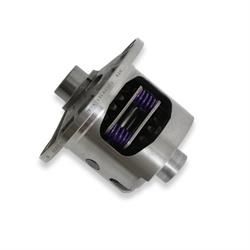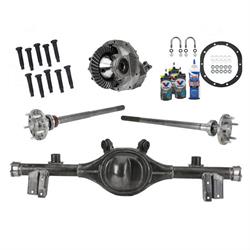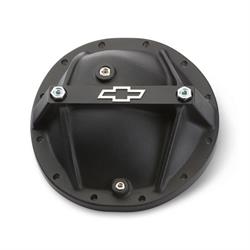GM 12-Bolt Rear End Identification & Upgrade Guide
One two three, four five, six seven, eight nine ten, eleven tweeeeeelllllllve… bolts. OK, so that was just for the Gen Xers out there who can’t only think about pinball right now. The classic GM 12-bolt rear end is the steeped in history, mystery, and fantasy. Let’s break down this venerable, yet elusive, drivetrain component that has long fueled the bench racing argument of which rear axle is the best rear axle.
There are several lauded axles in the world of hot rods, muscle cars, and trucks. The Ford 9-inch, the Chrysler 8 3/4, Dana 60, GM 10 bolt rear end (read this before you start clownin’), and of course, the Chevy 12 bolt. So other than brand loyalty, what is the reason to choose one over the other? In today’s aftermarket, you can get any of these style rear axles in any chassis arrangement, so why the 12-bolt over a 9-inch?
First off, while we mentioned them as a much-loved rear, we are going to drop the GM 10-bolt and 8-3/4 dodge rear end units from this article. While these are EXCEPTIONALLY good rears, their power handling stops at around 500hp (10-bolt), and 750hp (8-3/4), we are focusing on the GM 12-bolt rear axle for the remainder. Even though the Ford 9-inch gets more action in the aftermarket, when comparing stock to stock, the 12-bolt is a little stronger and more efficient, but more on that later.
What Years Did GM Make the 12-Bolt Rear End?
Released in 1964, two versions of the GM 12-bolt axle were used in cars and trucks. Considered the best performance car live-axle rear end from GM, the car 12-bolt gets its name from the number of bolts used to secure the ring gear to the differential, not the number of bolts on the rear cover, though those usually coincide. GM’s car 12-bolt was built for just eight years, from 1964 to 1972, making it extremely hard to find an original housing.
Vehicles built with 12-bolt car rears:
- 1964-1972 A-body (Chevelle, Cutlass, GTO)
- 1964-1972 B-body (Caprice, Impala)
- 1967-1972 F-body (Camaro, Firebird)
- 1964-1972 X-body (Chevy II, Nova)
Trucks and vans got a different version of the 12-bolt, this is called the “truck 12-bolt,” which was built from 1964 through 1987. The truck 12-bolt was the only rear end used in all GM trucks through 1972, until the corporate 10-bolt rear took over. The 12-bolt remained an option through 1987.
Are All GM 12-Bolt Rear Ends the Same?
Not even a little. There were car GM 12-bolt axles and truck versions, and nothing interchanges between the two versions. There are housing differences in each version as well, depending on the year and model they were installed in.
GM 12 Bolt Truck Rear End Details
Truck 12-bolt rears are weaker than the car versions, mainly due to the smaller interior components. The pinion gear shaft is 1.438-inch, smaller than the 1.675-inch of the car unit. The axles have 17 thick splines, and the differential itself is narrower. Identifying a truck 12-bolt is easy, it’s under a truck! The cover has an irregular shape with a raised area for the ring gear. 1963-72 truck housings have a Panhard bar mount near the top of the passenger side axle tube, just to the right of the center section. All truck housings have two lower mounts, either for trailing arms or leaf springs. Trailing arm mounts are located on the bottom of the axle tubes, slightly angled towards the center, while leaf spring pads are perpendicular to the axle tube and mounted at the top of the tubes. Truck rears have larger brakes than car rears. You can build a 12-bolt truck rear for high-performance, as these rears are much easier to find than car versions.
GM 12 Bolt Rear Axle Car Details
The car 12-bolt is nothing less than legendary. These units position the pinion gear higher on the ring gear, where there is less stress and friction, giving the 12-bolt a substantial boost in efficiency over the 9-inch Ford, about three percent better. That’s 3 hp per 100, at 500 hp, you have an effective boost of 15 plus ponies. Add to that the fact that the GM 12-bolt is 30 lbs. lighter, you can see why the 12-bolt is so popular.
Most car 12-bolts were installed in vehicles that used the triangulated 4-link rear suspension, meaning you have a pair of bushing mounts on the bottom and a pair of bushing eyelets astride the top of the center section which run on an outward angle. All GM passenger cars used this style except for the Camaro and Nova, which used leaf springs. The cover is an oval shape with an odd “hat” shape on the top of the cover; it is very distinctive.
Chart GM 12 Bolt Rear End Identification
Casting numbers for the 12-bolt housings are cast on the upper driver-side rear of the center section. For 1964-1969 applications the first character is a letter for the month of the year, A for January, B for February, etc. Followed by the day and the last digit is the year, for example - C287 would be March 28th, 1967. Starting with the 1970 model year the first two characters became digits, 01 for January, 02 for February, etc. Followed by the day and the last digit is the year, for example – 04173 would be April 17th, 1973. On the passenger-side front tube, the axle code is stamped, with a code for 1969 and earlier and a code for 1969 and later builds. 1969 and earlier codes have two letters, followed by a four-digit number, followed by a letter and possibly a shift number (1 for day, 2 for night) and a positraction code. For 1970 and later, these typically feature six to eight digits, including three letters, three numbers, and sometimes an additional number and letter. The first two letters indicate the gear ratio code, the third letter notes the build plant, the next three numbers are the build day from 001 to 365. Sometimes the shift code is stamped (1 for day 2 for night), and if the unit has a positraction, there will be a P stamp.
GM 12 Bolt Gear Ratio Chart
GM used three different differential carriers for the 12-bolts, each corresponding to a range of gear ratios. As the ratio gets smaller numerically, the pinion gear gets larger, so the ring gear must be positioned differently. There are three carrier series: 2, 3, and 4. The 2-series are by far the most common. The following is a list of the factory gear sizes available for each series in the passenger car 12-bolt.
What Is the Difference Between GM 10 Bolt and 12-Bolt?
The GM 10-bolt is a great rear axle, but only if you get the 8.5-inch unit, as the others are simply too small to survive anything over 400hp, and even then, the technical limit for a well-built 8.5-inch 10-bolt is 450hp with drag radials or 500hp with street tires. A stock 12-bolt car rear is good for 600ish horsepower, and a truck 12-bolt is good for about 550hp.
There is a formula to figure out what size axle you need, which is Engine Torque X 1st Gear Ratio X Rear Gear Ratio X .90 (this is for parasitic loss). For example, an engine with 500 lb.-ft of torque, 3.27 first gear, and 4.11 rear gear yields 6,047 lb.-ft of torque sent to both axles. Axles are rated individually, so you would divide this figure to determine the individual axle rating requirement (6,047/2= 3,023.5 lb-ft per axle). By reversing the math (and you said you would NEVER use algebra after high school…), you will find that the maximum engine torque limit for (2) 30-spline axles is 1,025 lb.-ft of flywheel torque (1,025 X 3.27 X 4.11 X .90= 12,398/2= 6,199 lb-ft). The stock differential, bearings, and possibly the housing will break before the axles in most cases. The stock axles are quite strong, and sufficient for most builds.
All GM 12-bolts use C-clip axles, which are retained by a C-shaped clip on the inside end of the axle shaft which sits in a recess on the ring carrier. These are strong enough for most uses, but if you break an axle, your entire wheel and axle can come out of the housing, which is bad news. One common upgrade is a C-clip eliminator kit, which is a bolt-on part. These are for drag racing only and should never be used on the street. The reason is that the eliminators are designed to handle forward-motion only, not side-load stress, as seen when cornering. Over time, the eliminators distort and leak. The better solution is to weld on a set of Ford “big bearing” housing ends, which utilize a bolt-on axle retainer and there is no worry about axle breakage disasters.
What Is the Difference Between GM 10 Bolt and 12-Bolt?
Options, that is the biggest reason outside of power level. A well-built 8.5-inch 10-bolt is good enough for 9-second Buick Grand Nationals that hang the front wheels for 60 feet, but the 7.5/7.625-inch and 8.2-inch variants are not good for much more than the stock drivetrain. The largest axle you can put in a 10-bolt is a 28 spline, the 12-bolts start there and can go up as high as 35 spline, so you get a lot of strength when you go to a 12-bolt. There are plenty of go-faster goodies for 8.5-inch 10-bolts, but again, the smaller units, not so much.
Does the GM 12-bolt axle have any downsides?
Of course it does, there is darkness on the other side of every bright light. GM 12-bolts are “carrier” style housings, meaning the differential carrier is part of the housing, using a removable cover to seal it. This is unlike the Ford 9-inch, which is a dropout style where the differential carrier is mounted to a third member. This is the biggest downside to the 12-bolt—the setup is much harder to do. Gear changes require a full tear down of the entire housing. A 9-inch Ford can get a gear swap in under 30 minutes by swapping to another “loaded” third member, where it takes hours for a 12-bolt.
Another issue is availability. If you are on a budget, finding a stock 12-bolt housing is tough, and even an empty used housing can cost $1,200-$1,500. For a third of that you can get a new Speedway Motors 9-inch A-body housing with axles and have lots of money left to fill it with stuff. For just over $2,200, you can get a full 9” with axles and gears (’64-’67 A-body example).
What Are The Best GM 12-Bolt Upgrades?
You can beef up a stock housing with axle tube braces, Ford bolt-in axle ends (requires welding and setup), and better axles. The rear axle cover is a good place to add some strength with a pre-load cover for truck 12-bolt or car 12-bolt that puts a bit of preload on the differential retainer caps, ensuring they don’t walk or deflect under heavy loads. This is a big one for carrier-style rear housings. Upgrading to a Limited-Slip (LSD) or locker is the most popular option, as ditching the open differential helps put that power to the ground where it belongs instead of into one spinny tire. The selection of 12-bolt car and truck axle parts available in the aftermarket is staggering.
The second most popular upgrade is new gears. Changing the rear gear ratio can turn a boring daily commute into a rip-roarin’ festival of speed and power, no other changes necessary. This comes with a caveat, however, as substantial changes have big effects. For example, we went from 3.08 gears to 4.11s in our 1971 Buick GS. Without overdrive, those 4.11s would have the old Buick 350 spinning WAY past its 6,000 rpm limit just to cruise at 70, but it was wildly quicker off the line, and the top speed suffered. Add in a .68 overdrive gear, and suddenly, those big gears are more manageable. If you go too big, you will lose top end speed and raise the engine rpms. Smaller gears take longer to get up to speed but allow your engine to spin slower at a higher vehicle speed. The point is that you want to find a good neutral ground when choosing gear ratios, and don’t forget the tires, larger tire diameter equals slower engine speed. It all works together. We find that 3.73s are about perfect for most cars and trucks being used as daily-drivers.
Don’t forget the disc brakes either. You can get disc brake upgrades for just about everything, the 12-bolt is no different. You must remove the axles to install a 12 bolt disc brake conversion kit, so you might as well upgrade the guts while you are there. Be sure to study up on how to convert drum brakes to disc brakes before tackling that project, because there can be key differences between these braking systems depending on your specific car.
GM 12-Bolt vs Ford 9-Inch
This is the big quandary, stick with GM or go to the enemy, Ford. The 12-bolt is lighter, more efficient, and nearly as strong as the 9-inch, but it suffers from parts availability. GM only made the 12-bolt for eight years, while Ford made the 9-inch from 1957 through 1986; it was in everything from V8 Mustangs to F150s and everything RWD in between. There are more options for 9-inch axles than 12-bolts, and there is a 9-inch housing made to fit dang near every popular car and truck ever made. Comparing a stock 12-bolt car axle to a stock 9-inch Ford unit, and the 12-bolt wins nearly every time, they are that good. It is the sheer number of parts options that make the 9-inch the king of rear ends. You can build a 9-inch with 35-spline axles to support 1,500hp cheaper than a 12-bolt, and the quick-change nature of a third-member housing cinch the win for the 9-inch, but if you are not racing and just want the best GM has to offer, the 12-bolt is where it’s at.
Whether you are a GM purist or just a regular gearhead, the 12-bolt rear end is considered to be one of the absolute best. In stock form, the 12-bolt car rear is about as strong as it gets at 600 lb-ft, only the Dana 60 can handle more power in stock form (650hp). If you want to keep your GM car or truck “all-GM,” then the 12-bolt is the best option, and Speedway Motors can help you get the most out of it.



